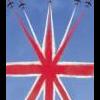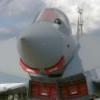

Rob de Bie
Members-
Posts
1,291 -
Joined
-
Last visited
Rob de Bie's Achievements

Very Obsessed Member (5/9)
1.4k
Reputation
-
I'm late to the party, but I checked Jane's all the world's aircraft, 1960-1961 issue, the last issue with the Pembroke. It lists a lot of wing data, but no dihedral angle. Rob
-
I copied the list below from my own web page about building the 1/72 Academy / Seminar model: https://robdebie.home.xs4all.nl/models/u2.htm - - - - Cutting Edge had an extensive line for the first-generation U-2 with twelve resin sets. Seven were discontinued in July 2006, the rest in February 2008 when Meteor Productions / Cutting Edge production was stopped. CEC48287 'U-2A Conversion'. Includes flat spine, rear fuselage, and adapter pieces for the smaller intakes. Note this set requires CEC48293 too CEC48288 'U-2A/C Super Detailed Cockpit'. See Hyperscale review CEC48289 'U-2A/C B-Camera Q-Bay'. Includes masks for camera windows CEC48290 'U-2E/F 'Ram's Horns' Conversion' CEC48292 'U-2A/F Exterior Upgrade'. Includes short spine 'canoe', landing gear struts, wheel well, air brakes and wells, U-2C wing inserts, trapezoid and other antennas. See Modeling Madness review CEC48293 'U-2A/D/E Seamless Intakes' CEC48294 'U-2C/F 'Coke Bottle' Seamless Intakes' CEC48298 'U-2A/C Seamless Exhaust'. Includes rear wheel well CEC48299 'U-2C/F 'Interim' Seamless Intakes'. Applicable to all U-2Cs before 1965. These intakes are significantly different from the 'coke bottle' intakes in the Testors kit. CEC48318 'U-2 HASP Conversion'. Contains 'hard nose' and side scoop CEC48325 'U-2C 'Flat Spine' Conversion'. All U-2Cs were built with the flat spine; the long dorsal canoe was not installed until late 1965. CEC48490 'U-2CT Conversion'. Adds a second cockpit to the Testors U-2C kit. Full airframe conversion, cockpit interior and ejection seat, and new clear resin canopy. It appears that this set was announced, but never issued - - - - I have eight of these sets, for reference for my 1/72 model. Rob
-
To add to the above, I wonder whether anyone has ever seen a decent photo of the A-camera Q-bay hatch? The A and B cameras were the main camera systems of the early U-2. The B-camera is out in the open, with a camera on display at Duxford AFAIK, and the hatch on a musuem aircraft. But none of that for the A-camera (again: AFAIK). Rob
-
I'm pretty sure that all 1/72 first generation U-2A/C models lack camera windows in the Q-bay hatch. Plus all references until say 2000 also skipped the subject. My very first 3D CAD project was to design a B-camera hatch, with tracker camera fairing and 'System 6' antennas. It's for the Academy kit. It also fits the Airfix kit, but it won't fit the Hobby Boss model as-is, since it has a different (but correct!) Q-bay hatch shape. I cast copies, more information here: https://robdebie.home.xs4all.nl/models/forsale.htm Rob
-
Rob de Bie started following "Best" Lockheed U-2 Kit
-
One more thing to consider when selecting a 1/48 scale kit: the original Hawk U-2A (J57 engine) and the modified Testors U-2C (J75 engine) have different rear fuselages I clamped the fuselages of these two models together. The difference is ~3.5 mm. Rob
-
Yes I do, great book! But AFAIK this information is not in there. Rob
-
I found my data again, here's a summary: Position Wing Station 1 to 1 1 to 48 Hawk / Testors AFV centerline 0 144" inner edge flap 37 136" 72.0 mm 67.0 mm 72,6 mm tip 480 36" 19.1 mm 18.9 mm 19.3 mm So there's 5 mm chord missing at the fuselage-wing connection of the Hawk / Testors model, tapering to almost zero at the tip. AFV is close to correct. However: this is unconfirmed data. I used the wing design parameters of the CL-282 early concept: aspect ratio 10 and wing taper 0.25. For the CL-282, I found the root (centerline) and tip chords in 'CIA draft report Kelly Johnson': 136" and 34" for a 500 sqft wing. Scaled up for a 600 sqft wing of the U-2A/C and a 960" span (excluding wing endplates), I calculated root and tip chords of 144" and 36". I find the very round 600 sqft figure especially suspect, but it's all we have. Rob
-
If you go for the Hawk/Testors/Italeri U-2A/C model, there's an annoying problems with the wing roots, one being positioned higher (or lower) than the other. I think Jan Forsgren was the first to spot and repair it: http://hsfeatures.com/features04/u2a48jf_1.htm I checked it on my models, and that confirmed the problem. I put the fuselage halves together with tape, and put a rod (bicycle spoke maybe) through the wing slots. Also, the wing chord of the model is too small. But otherwise it looks very good to my eye. Rob
-
Markus, thanks for the very kind offer! But I really need to finish my 234B first.. Plus dozens of other projects.. 🙂 Rob
-
Markus, thanks for the additional details! Drawings of the skid would be very useful indeed. From what I can see it has two fairly massive oleo cylinders. A fascinating design!! Rob
-
Michael, thanks for the recommendation! No, I don't have this book. In fact, I have only one decent source: Luftfahrt LD21 'Arado 234 - der erste Strahlbomber der Welt'. And more importantly, I need to finish my B-model first! I started that as a stress-free zero-research straight-from-the box project, but slowly I started doing more and more research and corrections to the model. Read and weep here: https://robdebie.home.xs4all.nl/models/ar234.htm. I do have a second kit in stock, in case my Ar 234A plans would be feasible. Rob
-

RAF Germany Jaguar stores fit, late 70's to early 80's
Rob de Bie replied to Mr T's topic in Aircraft Cold War
As spotters we went to Bruggen regularly, and I don't recall them either. In my memory they nearly always flew in the same configuration. Same at Laarbruch with the large photo pod. Rob -
SafetyDad, that sounds like a logical explanation. After reading the two threads on Large Scale Planes, I made an interesting discovery. There the Fly 1/32 scale model is linked to the drawings in Aero Detail 16. But the Dragon model precedes that publication. Then I saw the drawings in AeroModeller magazine, March 1972 issue (download from the RC Bookcase: https://rcbookcase.com/details.php?publication_id=2557). It's a six-page article with very nice drawings by Barrie Hygate (who wrote 'British Experimental Jet Aircraft' in 1990). Almost every drawing item checked perfectly with the Dragon model, down to the smallest detail. Take the row of hatches beneath the wing's leading edge as an example. The drawing is also the source of the flap segments that are too small. The Aero Detail 16 drawings look an awful lot like those from AeroModeller, so much that I believe they are basically copies. The only difference that I spotted so far, except for some choices in what to show, is the periscope in the front view drawing. Plus they added drawings of the later versions. Rob
-
Markus, another thanks! I hadn't studied that A-canopy in detail, but it certainly is different. Rob
-
Markus, thanks! I hadn't found this site / e-book yet. Rob






